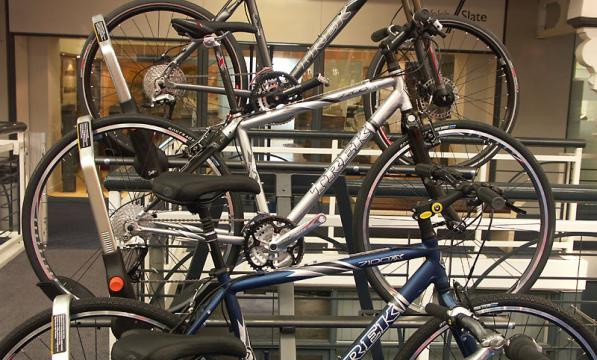Safety Regulations

These regulations apply only to those who sell new bikes, bike shops in other words, and are not something that cyclists usually need to know about. But if you think you have been sold an unsafe bicycle, it might be worth checking whether the retailer seems to have contravened one of the requirements of PBSR.
General Safety
When first enacted, in 1983, the major requirement of PBSR was to ensure that every new bicycle sold conformed to the British Standard for bicycles: BS6102 part 1.
In 2005 Britain adopted the European General Product Safety Regulations (GPSR). These forbid the marketing of unsafe products, whilst presuming the safety of any product that conforms to an appropriate published standard, especially if it's a European standard. And at about the same time BS6102/1 was being superseded by a bunch of European Standards, upgraded from the old BS and differentiated according to types of bicycles.
GPSR allows a few other ways of establishing that a product is safe, but nevertheless does pretty much the same thing for all products, as PBSR was doing for bicycles. So when the bicycle regulations were most recently revised (by Statutory Instrument 2010 No. 198): the requirement to conform to a standard was left out. Cycle manufacturers were by then well accustomed to standards and it is rare to find a bicycle offered for sale without a "Conforms to BSEN..." sticker on it.
If you think you have been sold an unsafe bicycle, it might be worth checking whether the retailer seems to have contravened one of the requirements of PBSR.
Chris Juden, Cycling UK
Specific requirements
One might suppose that the remaining provisions of this regulation were comparatively trivial, and so they are. Every new bicycle has to come with:
- Any hand-operated brakes arranged left-hand rear, right-hand front
- A bell
- White or yellow reflectors on both sides of each wheel or tyre
- A white wide-angle front reflector, or a front lamp
- A red wide-angle rear reflector
- Yellow reflectors front and rear on each pedal
The reflectors (or front lamp) required above must be of a specification that is approved by UK Lighting Regulations.
A bike that is sold fully assembled must come exactly so, with all these things fitted as described. But a bike that is sold as a kit, or with some parts un-assembled (most likely items 2 to 6 above), merely has to be capable of being assembled like so. In that case it must come with assembly instructions plus any special tools.
Exceptions
This regulation is about bicycles, so unicycles, tricycles and quadricycles, are completely exempt. But almost everything with two wheels is included, i.e. tandems, delivery bikes, etc.
It's about new bikes offered for sale, so used (i.e. secondhand) bikes and any bikes offered for hire are not included. And it's about bikes that could be used on British roads, so bikes with no brakes for racing on enclosed tracks (i.e. velodromes), bikes for export and bikes on which the saddle cannot be raised more than 635mm above the road are also excluded. The last exclusion is intended for very small children's bikes, that are unlikely to go on the road, but inadvertently also lets most recumbent bikes off the hook!
There's also an exemption for bikes that are made to the design and for the use of an individual customer, but only if that customer intends to use the bike in competitive events. Accordingly, in order for a touring cyclist (for example) to obtain exactly what he or she wants in a custom-built bike, or to have the brakes on any new bike connected front left, rear right (it'll be safer if that's what they're accustomed to, having learnt to ride abroad), it may be necessary to pretend an enthusiasm for bicycling treasure hunts, map-reading competitions and the like!
Since the 2010 revision, the expression “bicycle” now includes a substantially complete vehicle (whether or not assembled) even if one or more parts are omitted. This closed the loophole by which retailers used to dodge this regulation by not including pedals.
After sales alterations
All of this applies only at the initial point of sale. The customer, once they own the bike, is free to make (or have made by the dealer) whatever alterations they wish. But it's difficult (maybe expensive) to switch over the brakes when the cables are already under the handlebar tape, which is why one may need to engage in the little competitive fiction mentioned above!
Many cyclists have a strong aversion to what they view as excess clutter on their bike and will want to remove (or never fit) most if not all of the items 2 to 6, listed above. Since none of them are required by Construction and Use Regulations, the bicycle will still be perfectly legal to use, on the roads of Great Britain, in daylight.
If the bike will also be used at night, items 5 and 6, the rear and pedal reflectors should certainly be retained, since these, plus an approved front and rear lamp, are required by Lighting Regulations. But the front and wheel reflectors can be discarded in any case, since these are optional and probably quite useless in actual fact, even at night.
It might also be a good idea to leave the bell in place, especially if the bike will also be used outwith Great Britain. That's because a bell is part of the minimum equipment for international use of a pedal cycle, required by the 1968 Vienna Convention on Road Traffic. This means that if you visit somewhere that requires it's own people to have bells on their bikes, you can't claim exemption as a visitor. Such territories, it might surprise you to learn, include Northern Ireland and the Isle of Man, each of which have their own special versions of the Road Traffic Acts. For more about that, see Construction and Use.

